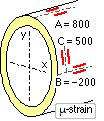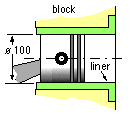| OD | Wall thickness | ||||||||
| 3.6 | 4.0 | 4.5 | 4.9 | 5.4 | 5.9 | 6.3 | 8.0 | 9.5 | |
| 60.3 | X | X | X | X | X | ||||
| 76.1 | X | X | X | X | X | X | |||
| 88.9 | X | X | X | X | X | X | |||
| 101.6 | X | X | X | ||||||
| 114.3 | X | X | X | X | X | ||||
| 139.7 | X | X | X | X | X | ||||
| 165.1 | X | X | X | X | X | ||||
- the mean diameter Dm = ( Di + Do )/2, as used in AS 1210, or
- the outside diameter Do (giving the so-called 'Barlow's formula')
- Calculate the error using Di, Dm and Do in turn for a closed steel cylinder with Di/t = 25.
- Derive the basic AS 1210 design formula for thin cylinders subjected to internal pressure pi, namely :
t = Di /( 2 σd / pi - 1 ) where σd is the allowable (design) stress. - A pressure vessel to contain steam at 2 MPa is designed to AS 1210 with a design stress of 80 MPa. The vessel is 780 mm bore, 2.5 m long and simply supported over a 2 m span. Is bending significant when the vessel is filled with water for an hydraulic test?

| ========== Inside ========== | ===== Outside ===== | |||||||||||||
| Cylinder | Fa | D | p | σt | σr | εD | σ* | D | p | σt | σr | εD | ||
| kN | mm | MPa | MPa | MPa | x104 | MPa | mm | MPa | MPa | MPa | x104 | |||
| a | open | 0 | 40 | 120 | 60 | -120 | 4.6 | 180 | 120 | 40 | -20 | -40 | -0.4 | |
| b | open | 0 | 20 | 190 | 125 | -190 | 8.8 | 315 | 60 | 50 | -15 | -50 | 0 | |
| c | open | 0 | 15 | 120 | 40 | -120 | 3.7 | 160 | 60 | 45 | -35 | -45 | -1.0 | |
| d | closed | 0 | 60 | 75 | 125 | -75 | 6.76 | 200 | 120 | 0 | 50 | 0 | 2.1 | |
| e | closed | 600 | 60 | 0 | -59 | 0 | -1.4 | 100 | 120 | 22 | -37 | -22 | 0 | |
- the material's yield is 200 MPa; use the distortion energy theory [ 69 mm ]
- ditto - but using the maximum shear stress criterion
- the brittle material has tensile and compressive ultimates of 200 and 700 MPa. [ 56 mm ]
If a single cylinder had been used in this application
- what pressure could it withstand if it were the same overall size and the equivalent stress was limited to 82 MPa? [ 35 MPa ]
- what outside diameter would it need to be to contain the pressure of 50 MPa with a maximum equivalent stress of 82 MPa?

- determine the necessary diametral interference [ 0.04 mm ]
- plot the variation of equivalent stress through both walls
- ascertain the safety factor. [ 4.9 ]
- the optimum choice of interface diameter Dc is such that :
γoinner = γoouter = Γ1/2 = 1 /( 1 - n pi / Sy ) - the corresponding optimum interference is : Δopt = pi Dc /E